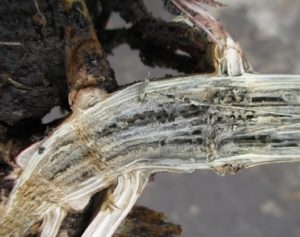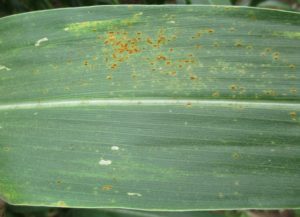This season has been unusual for corn diseases. Early in the year, starting in south Texas and progressing north, the fungal disease, northern corn leaf blight (Figure 1), has been very prevalent. Usually, a few lesions of the disease are seen on the lowest leaves and the disease never progresses. Disease development is driven by frequent rain and temperatures lower than 80°F. In a typical Texas growing season, infrequent rain, but moreover increasing temperatures will hinder the fungus. Weather conditions early in the season supported disease development. There are differences in susceptibility of hybrids and there was more disease development in more susceptible hybrids.
Another observation was that there was a high prevalence of disease in corn cropped on land where the previous crop was corn. The pathogen carries over to the next season in crop residue. In cases when the disease was especially severe, the field should be rotated out of corn the following year and crop residue should be plowed under, to hasten its decomposition.
In this season, there were grower questions about the need to apply fungicides. Northern corn leaf blight has been such a minor disease in Texas that there have been no studies to define a benefit of a fungicide application. In the Midwestern US, yield loss can occur if there is a substantial amount of disease at the time of silking. If high levels of disease is delayed until several weeks after silking, there is minimal disease loss. Until there is more data for Texas, the trigger for a fungicide application would be increasing disease development in a susceptible variety near or at silking, with a forecast of future rainy weather. A fungicide application would not be necessary for this disease later in the season.
Figure 1. Lesions of northern corn leaf blight, caused by the fungus, Exserohilum turcicum.
Another unusual aspect about this season is that in areas where northern corn leaf blight was prevalent, there was also development of charcoal rot (Figure 2), a soilborne fungal disease that is more typical for the Texas climate. The earliness of the appearance of this disease was unusual, although its appearance did coincide with extended dry weather conditions.
Figure 2. Internal stalk rot with tiny, black fungal structures (microsclerotia) of the charcoal rot fungus, Macrophomina phaseolina.
Commonly, in the field, there were a few dying plants, drying up, surrounded by plants that were still green (Figure 3). The disease is easy to diagnose in the field: slit the stalks lengthwise near the base and look for rot, along with the diagnostic small, black survival structures (microsclerotia) of the fungus. Sometimes, however, the plant death is so rapid that microsclerotia haven’t formed yet. In that case, plants should be checked a few days later.
The development of this disease is triggered by moisture stress, particularly in plants that may not have developed extensive root systems early in the season, sometimes because of frequent rains. While all hybrids are likely susceptible to fungal infection, symptom development can be restricted in hybrids that are better adapted to surviving moisture stress. Water management options are limited in dryland corn, but cultural practices that reduce moisture stress are helpful. This includes a lower plant population and elimination of soil compaction. Crop rotation is not effective for managing this disease.
Figure 3. Premature death of corn plants caused by the charcoal rot fungus.
Early in the season, alongside the northern corn leaf blight, there was also common rust. Like northern corn leaf blight, this disease is driven by rain and cool temperatures early in the season. Its presence is no threat to yield in Texas corn. On the other hand, southern rust (Figure 3) could threaten yield in susceptible hybrids, especially if they are planted late. At this writing, southern rust is present in south and central Texas. The corn in south Texas is too far along in maturity for the disease to be a concern, but there may be corn in central Texas that is at the milk stage or younger, and this corn may be vulnerable to yield loss, in the event of future rain that would increase disease development.
The fungus does not survive on crop residue. Spores are blown into fields from other areas of corn production. In Texas, the progression is from south to north. In addition to rain as a factor in disease development, the disease can be more severe in furrow-irrigated corn.
My free bulletin, “Southern Rust of Corn and Its Management in South Texas” (EPLP-049), available from the Texas AgriLife Bookstore, gives guidance on the identification of southern rust and decision making for a fungicide application.
Figure 4. Pustules of the southern rust fungus, Puccinia polysora.
Thomas Isakeit, Professor and extension plant pathologist
Texas A&M AgriLife Extension Service, College Station
t-isakeit@tamu.edu; cell 979-229-4976



